The Multi-item patient Monitor Market is estimated to be valued at USD 43.4 billion in 2025 and is projected to reach USD 61.8 billion by 2035, registering a compound annual growth rate (CAGR) of 3.6% over the forecast period.
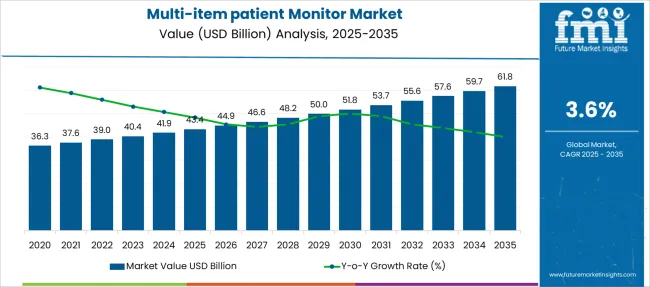
| Metric | Value |
|---|---|
| Multi-item patient Monitor Market Estimated Value in (2025 E) | USD 43.4 billion |
| Multi-item patient Monitor Market Forecast Value in (2035 F) | USD 61.8 billion |
| Forecast CAGR (2025 to 2035) | 3.6% |
The multi-item patient monitor market is evolving rapidly due to the increasing burden of chronic diseases, rising surgical volumes, and advancements in continuous monitoring technologies. Healthcare providers are prioritizing integrated patient monitoring systems to improve diagnostic efficiency and patient safety.
The market is further propelled by increased healthcare digitization, greater interoperability between devices, and demand for centralized data management systems across acute and critical care units. Innovation in non-invasive monitoring, wireless communication protocols, and AI-based alert systems is enhancing adoption across hospitals and specialty centers.
Regulatory mandates for patient safety and remote monitoring infrastructure development are opening new opportunities, especially in high-acuity environments. Going forward, integration with electronic health records (EHRs), real-time analytics, and portable monitoring solutions are expected to drive long-term growth across clinical settings.
The market is segmented by Acuity Type, Application, and End-User and region. By Acuity Type, the market is divided into High-acuity monitors, MRI-compatible monitors, Critical care monitors, Peri-operative monitors, Medium-acuity monitors, Post-anaesthesia care monitors, Emergency care monitors, and Low-acuity monitors. In terms of Application, the market is classified into Cardiology, Neurology, Respiratory, Fatal & Neonatal, Remote Monitoring, Weight Monitoring, and Temperature Monitoring. Based on End-User, the market is segmented into Hospitals, Ambulatory Care Centers, Clinics, Diagnostic Laboratories, and Home-care Settings. Regionally, the market is classified into North America, Latin America, Western Europe, Eastern Europe, Balkan & Baltic Countries, Russia & Belarus, Central Asia, East Asia, South Asia & Pacific, and the Middle East & Africa.
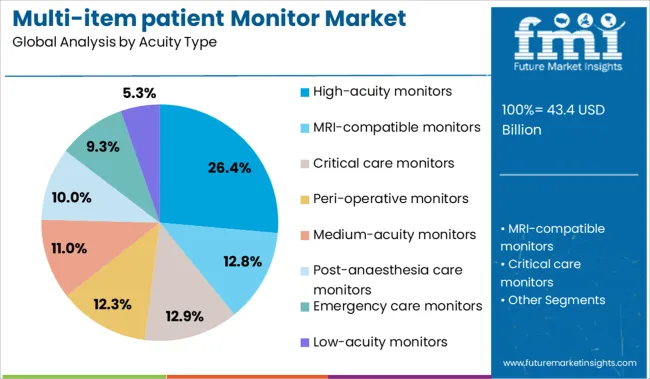
High-acuity monitors are projected to contribute 26.40% of the total revenue share in 2025, establishing themselves as the leading acuity type segment. Their dominance is driven by the need for continuous, real-time monitoring in intensive care units (ICUs), emergency departments, and post-operative recovery areas.
These systems offer advanced features such as multi-parameter tracking, integrated alarm systems, and support for invasive monitoring, which are essential in managing critically ill patients. Their ability to interface with life-support devices and EHR platforms enhances workflow efficiency and patient outcomes.
Rising investment in critical care infrastructure and the emphasis on reducing preventable adverse events are reinforcing the segment’s growth across both developed and emerging healthcare markets.
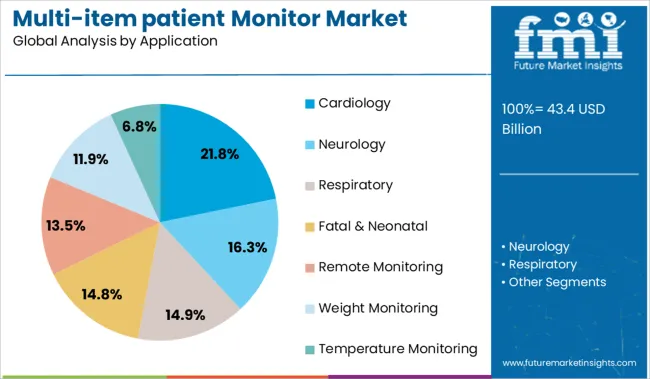
Cardiology applications are expected to account for 21.80% of the market share in 2025, making it the leading clinical use case for multi-item patient monitors. This growth is driven by the increasing prevalence of cardiovascular conditions, which require continuous ECG, blood pressure, oxygen saturation, and arrhythmia monitoring.
Multi-item monitors have proven essential in providing timely insights during acute cardiac episodes, catheterization procedures, and long-term heart failure management. With aging populations and sedentary lifestyles contributing to rising cardiac morbidity, cardiology departments are integrating these systems to enhance early detection and optimize treatment strategies.
Advanced waveform analysis and automated reporting features are enabling clinicians to improve diagnostic accuracy while streamlining data integration within cardiology workflows.
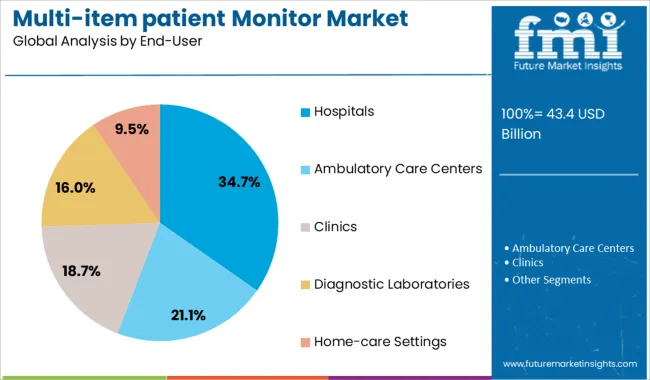
Hospitals are projected to hold 34.70% of the revenue share in 2025, positioning them as the largest end-user segment in the multi-item patient monitor market. This leadership is attributed to the comprehensive need for continuous monitoring across various departments, including operating rooms, ICUs, emergency care, and general wards.
Hospitals are also better positioned to invest in high-spec, network-integrated monitoring infrastructure that supports clinical decision-making and compliance with quality care protocols. The adoption of hospital-wide patient monitoring systems is also being supported by national health initiatives, insurance-driven mandates, and the drive to reduce patient readmission rates.
Demand for scalable, interoperable systems and centralized monitoring capabilities is expected to remain high as hospitals continue modernizing their digital health infrastructure.
The high demand for real-time patient monitors in critical care units, growing product penetration and popularity across regions, growing demand for early diagnosis and treatment of chronic diseases, documenting changes in a patient’s condition at every stage, and the need to make better clinical decisions on the spot are the major factors that are expected to fuel the market growth over the analysis period.
Multi-item patient monitors are consistently being improved in technology, especially for better algorithm-based monitoring. Remote patient monitoring has evolved over the years and thus, which in turn boosts the demand for multi-item patient monitors over time.
Several macro-economic factors such as an increase in healthcare expenditure, improved healthcare infrastructure, and rise in disposable income are also expected to contribute to the growth of the multi-item patient monitor market during the forecast period.
Additionally, a paradigm shift of multi-item patient monitors for use in hospitals to use in mobility services and ambulatory centers is other major factor that is expected to augment the growth of the multi-item patient monitors in the near future.
The lack of maintenance of Multi-item patient monitors during economic crisis in developing regions is one of the major factors that is anticipated to impede the growth of the multi-item patient monitoring market over the forecast period.
Additionally, the high costs associated with these monitors, coupled with poor reimbursement policies for the device might hamper the market growth for multi-item patient monitors during the analysis period.
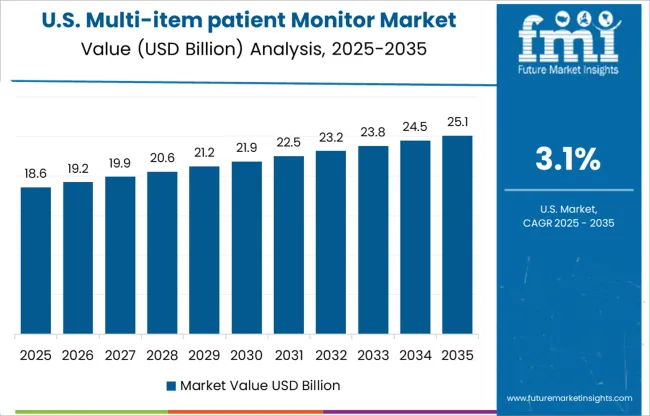
The Multi-item patient Monitor market in North America is expected to hold largest share of USD 34.6 Billion. Considering the revenue generation, the regional market is expected to reach at a CAGR of 2.97% during the forecast period.
The multi-item patient monitoring market in North America is expected to dominate the global market, owing to the high product penetration and growing number of intensive care facilities and improved healthcare infrastructure in the region.
Moreover, factors such as more initiatives to provide advanced products, higher research expenditure, and private-public partnerships are expected to propel the North America’s multi-item patient monitoring market. In addition, the high prevalence of chronic diseases and the introduction of supportive reimbursement schemes are some vital factors governing the growth of the market in this region.
The Asia-Pacific Multi-item patient Monitor market is expected to reach at a CAGR of 1.54% with a market value of USD 25.4 Billion. Additionally, Southeast Asia is facing an increase in the trend for these monitors, attributed to the use of multi-item patient monitors via Wi-Fi and other networks.
Increasing per capita income, economic development, and unmet needs of a large population in the Asia Pacific region are expected to contribute to the regional market growth. Rising demand for remote patient monitoring and related services due to the increasing government spending on healthcare is anticipated to augment the market growth.
Furthermore, China is the leading producer of low-cost electronic chips and products. Hence, it is projected to attract investors in China, thereby contributing to the market growth.
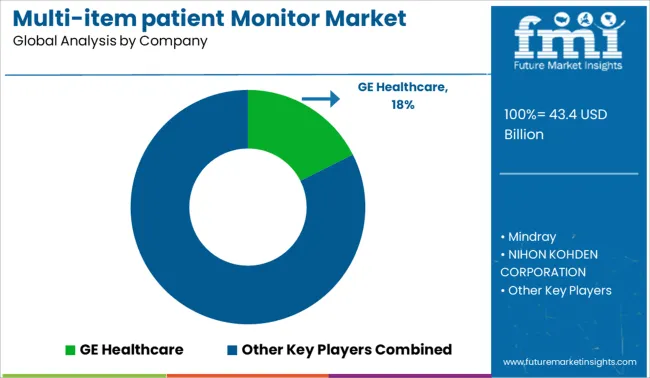
Some of the key participants present in the global Multi-item patient Monitor market include GE Healthcare, Mindray, NIHON KOHDEN CORPORATION, Koninklijke Philips N.V., OSI Systems, Inc, Microchip Technology Inc., Hipac Healthcare Pty Ltd, Arjo, Schiller, Heyer Medical AG, SUNRAY MEDICAL APPARATUS CO.LTD, TENKO MEDICAL, Drägerwerk AG & Co. KGaA and Fukuda Denshi, among others.
Attributed to the presence of such a high number of participants, the market is highly competitive. While global players such as GE Healthcare, Mindray, NIHON KOHDEN CORPORATION, Koninklijke Philips N.V., OSI Systems, Inc, and Microchip Technology Inc., account for a considerable market size, several regional level players are also operating across key growth regions, particularly in the North America.
| Report Attribute | Details |
|---|---|
| Growth Rate | CAGR of 3.6% from 2025 to 2035 |
| Base Year for Estimation | 2024 |
| Historical Data | 2020 to 2024 |
| Forecast Period | 2025 to 2035 |
| Quantitative Units | Revenue in USD Million and CAGR from 2025 to 2035 |
| Report Coverage | Revenue Forecast, Volume Forecast, Company Ranking, Competitive Landscape, Growth Factors, Trends and Pricing Analysis |
| Segments Covered | Acuity Type, Application, End-User, Region |
| Regional Scope | North America, Latin America, Western Europe, Eastern Europe, Asia Pacific, China, Japan, Middle East and Africa |
| Country Scope | USA, Canada, Mexico, Brazil, UK, Germany, France, Spain, Italy, Poland, Russia, China, India, ASEAN, Australia, New Zealand, GCC, South Africa, North Africa |
| Key Companies Profiled | GE Healthcare, Mindray, NIHON KOHDEN CORPORATION, Koninklijke Philips N.V., OSI Systems, Inc, Microchip Technology Inc., Hipac Healthcare Pty Ltd, Arjo, Schiller, Heyer Medical AG, SUNRAY MEDICAL APPARATUS CO.LTD, TENKO MEDICAL, Drägerwerk AG & Co. KGaA and Fukuda Denshi, among others |
| Customization Scope | Free report customization (equivalent to up to 8 analysts working days) with purchase. Addition or alteration to country, regional & segment scope. |
| Pricing and purchase options | Avail customized purchase options to meet your exact research needs. |
The global multi-item patient monitor market is estimated to be valued at USD 43.4 billion in 2025.
The market size for the multi-item patient monitor market is projected to reach USD 61.8 billion by 2035.
The multi-item patient monitor market is expected to grow at a 3.6% CAGR between 2025 and 2035.
The key product types in multi-item patient monitor market are high-acuity monitors, mri-compatible monitors, critical care monitors, peri-operative monitors, medium-acuity monitors, post-anaesthesia care monitors, emergency care monitors and low-acuity monitors.
In terms of application, cardiology segment to command 21.8% share in the multi-item patient monitor market in 2025.






Full Research Suite comprises of:
Market outlook & trends analysis
Interviews & case studies
Strategic recommendations
Vendor profiles & capabilities analysis
5-year forecasts
8 regions and 60+ country-level data splits
Market segment data splits
12 months of continuous data updates
DELIVERED AS:
PDF EXCEL ONLINE
Patient-Controlled Analgesia Pumps Market Size and Share Forecast Outlook 2025 to 2035
Patient Transportation Market Size and Share Forecast Outlook 2025 to 2035
Patient Handling Equipment Market Size and Share Forecast Outlook 2025 to 2035
Patient Positioning Equipment Market Size and Share Forecast Outlook 2025 to 2035
Patient Self-Service Kiosks Market Size and Share Forecast Outlook 2025 to 2035
Patient Recliners Market Size and Share Forecast Outlook 2025 to 2035
Patient Transport Services Market Size and Share Forecast Outlook 2025 to 2035
Patient Engagement Platforms Market Size and Share Forecast Outlook 2025 to 2035
Patient Registry Software Market Size and Share Forecast Outlook 2025 to 2035
Patient Positioning System Analysis by Product Type and by End User through 2035
Patient Lateral Transfer Market - Innovations, Demand & Forecast 2035
Patient Identification Wristbands Market Analysis – Size, Trends & Forecast 2025 to 2035
Patient Hygiene Aids Market – Demand & Forecast 2024 to 2034
Patient Portal Market – Growth & Forecast 2024-2034
Patient-Controlled Injectors Market
Patient Health Management Market
Patient Monitoring System Market Size and Share Forecast Outlook 2025 to 2035
Patient Monitoring Accessories Market Size and Share Forecast Outlook 2025 to 2035
Patient Monitoring Devices Market Size and Share Forecast Outlook 2025 to 2035
Patient Monitoring Pods Market

Thank you!
You will receive an email from our Business Development Manager. Please be sure to check your SPAM/JUNK folder too.
Chat With
MaRIA